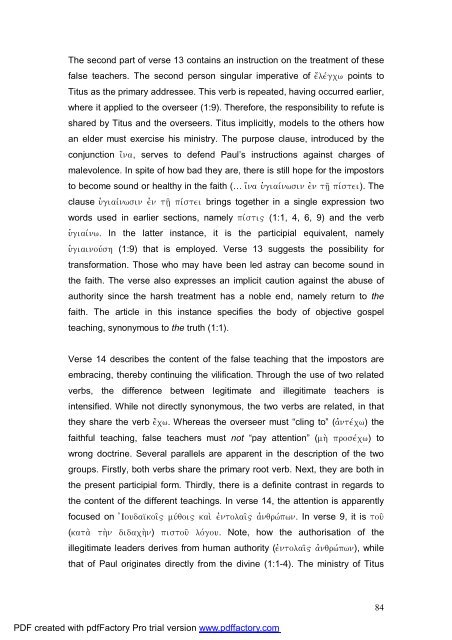A Text centred rhetorical analysis of Paul's Letter to Titus
A Text centred rhetorical analysis of Paul's Letter to Titus
A Text centred rhetorical analysis of Paul's Letter to Titus
You also want an ePaper? Increase the reach of your titles
YUMPU automatically turns print PDFs into web optimized ePapers that Google loves.
The second part <strong>of</strong> verse 13 contains an instruction on the treatment <strong>of</strong> these<br />
false teachers. The second person singular imperative <strong>of</strong> e[levgcw points <strong>to</strong><br />
<strong>Titus</strong> as the primary addressee. This verb is repeated, having occurred earlier,<br />
where it applied <strong>to</strong> the overseer (1:9). Therefore, the responsibility <strong>to</strong> refute is<br />
shared by <strong>Titus</strong> and the overseers. <strong>Titus</strong> implicitly, models <strong>to</strong> the others how<br />
an elder must exercise his ministry. The purpose clause, introduced by the<br />
conjunction i{na, serves <strong>to</strong> defend Paul’s instructions against charges <strong>of</strong><br />
malevolence. In spite <strong>of</strong> how bad they are, there is still hope for the impos<strong>to</strong>rs<br />
<strong>to</strong> become sound or healthy in the faith (… i{na uJgiaivnwsin ejn th`/ pivstei). The<br />
clause uJgiaivnwsin ejn th`/ pivstei brings <strong>to</strong>gether in a single expression two<br />
words used in earlier sections, namely pivsti~ (1:1, 4, 6, 9) and the verb<br />
uJgiaivnw. In the latter instance, it is the participial equivalent, namely<br />
uJgiainouvsh (1:9) that is employed. Verse 13 suggests the possibility for<br />
transformation. Those who may have been led astray can become sound in<br />
the faith. The verse also expresses an implicit caution against the abuse <strong>of</strong><br />
authority since the harsh treatment has a noble end, namely return <strong>to</strong> the<br />
faith. The article in this instance specifies the body <strong>of</strong> objective gospel<br />
teaching, synonymous <strong>to</strong> the truth (1:1).<br />
Verse 14 describes the content <strong>of</strong> the false teaching that the impos<strong>to</strong>rs are<br />
embracing, thereby continuing the vilification. Through the use <strong>of</strong> two related<br />
verbs, the difference between legitimate and illegitimate teachers is<br />
intensified. While not directly synonymous, the two verbs are related, in that<br />
they share the verb e[cw. Whereas the overseer must “cling <strong>to</strong>” (ajntevcw) the<br />
faithful teaching, false teachers must not “pay attention” (mh; prosevcw) <strong>to</strong><br />
wrong doctrine. Several parallels are apparent in the description <strong>of</strong> the two<br />
groups. Firstly, both verbs share the primary root verb. Next, they are both in<br />
the present participial form. Thirdly, there is a definite contrast in regards <strong>to</strong><br />
the content <strong>of</strong> the different teachings. In verse 14, the attention is apparently<br />
focused on jIoudai>koi`" muvqoi" kai; ejn<strong>to</strong>lai`" ajnqrwvpwn. In verse 9, it is <strong>to</strong>u`<br />
(kata; th;n didach;n) pis<strong>to</strong>u` lovgou. Note, how the authorisation <strong>of</strong> the<br />
illegitimate leaders derives from human authority (ejn<strong>to</strong>lai`" ajnqrwvpwn), while<br />
that <strong>of</strong> Paul originates directly from the divine (1:1-4). The ministry <strong>of</strong> <strong>Titus</strong><br />
PDF created with pdfFac<strong>to</strong>ry Pro trial version www.pdffac<strong>to</strong>ry.com<br />
84

















